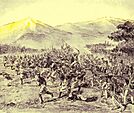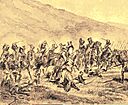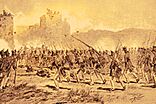Java War facts for kids
Quick facts for kids Java War |
|||||||
|---|---|---|---|---|---|---|---|
| Part of the Dutch colonial campaigns | |||||||
|
|
|||||||
|
|||||||
| Belligerents | |||||||
| Javanese rebels | |||||||
| Commanders and leaders | |||||||
|
|
||||||
| Strength | |||||||
| 50,000 | 100,000 | ||||||
| Casualties and losses | |||||||
| 15,000 killed (8,000 Dutch and 7,000 native) | 20,000 killed | ||||||
| 200,000 Javanese civilian killed | |||||||
The Java War was a big fight in central Java from 1825 to 1830. It was also called the Diponegoro War. This war happened between the Dutch Empire, who ruled the area, and local Javanese rebels.
The war began when Prince Diponegoro, an important Javanese leader, started a rebellion. He had worked with the Dutch before, but things changed. His forces tried to take over Yogyakarta, a key city. This gave the Dutch time to bring in more soldiers.
The Dutch army, with help from European and colonial troops, ended the siege of Yogyakarta in 1825. After this, the rebels fought a guerrilla war for five years. The war ended with a Dutch victory. Prince Diponegoro was captured after being invited to a peace meeting.
The war was very expensive for the Dutch. Because of this, they made big changes in the Dutch East Indies to make sure their colonies made more money.
Contents
Why the Java War Started
The main reason the Java War began was a simple decision by the Dutch. They wanted to build a road right through Prince Diponegoro's land. This land included the tomb of his parents, which was a very important and sacred place to him.
But there were also deeper problems that had been building up for a long time.
- Unhappy Leaders: Javanese noble families were upset. The Dutch had made rules that limited how much money these families could earn from their land.
- Dutch Power: The Dutch wanted more control over the court in Yogyakarta. They didn't want to lose their influence there.
- Cultural Differences: Prince Diponegoro was a very religious Muslim. He was worried about how relaxed religious practices were becoming at the court. He also disliked the growing influence of Christian Dutch people and the court's friendly ties with the Dutch. Many of his followers saw the war as a fight for their faith against the Dutch and against Javanese people who seemed to turn away from their traditions.
- Family Troubles: The Dutch also made a family problem worse. Prince Diponegoro was the oldest son of the previous ruler, Hamengkubuwono III. However, his mother was not the queen, which made his right to become the next ruler unclear. The Dutch supported his younger half-brother and then his baby nephew for the throne. This made it harder for Diponegoro to become king.
How the Fighting Began
The Java War officially started on July 21, 1825. Prince Diponegoro began his rebellion at his home in Selarong. At first, his rebel forces were very successful. They quickly took control of central Java and surrounded the city of Yogyakarta. Most Javanese people supported Prince Diponegoro's cause.
However, as the war went on, Prince Diponegoro found it hard to keep his army together. On the other hand, the Dutch colonial army was able to get more soldiers. They brought in local troops from Sulawesi and later received more European soldiers from the Netherlands.
The Dutch commander, General de Kock, managed to end the rebel siege on Yogyakarta on September 25, 1825.
Years of Guerrilla Warfare
After losing Yogyakarta, Prince Diponegoro changed his strategy. He started a long guerrilla war. This meant his forces used surprise attacks and hid in the countryside. Until 1827, the Dutch army struggled to control the Javanese countryside.
To fight the guerrillas, the Dutch built many small forts across central Java. They also used mobile groups of colonial troops to protect their territory. It's thought that about 200,000 people died during this war. This included around 8,000 Dutch soldiers.
The rebellion finally ended in 1830. Prince Diponegoro was tricked into going to Dutch-controlled land near Magelang. He thought he was going to talk about a possible peace agreement. Instead, he was captured. He was sent away to Manado and then to Makassar, where he died in 1855.
What Happened After the War
The Java War had a huge impact on Java and the Dutch.
- Many Deaths: Dutch records suggest that about 200,000 Javanese people died. Only about one-tenth of these deaths were from fighting. The rest died from sickness, hunger, and other problems caused by the war. About 15,000 Dutch soldiers died, with 8,000 of them being Europeans.
- New Soldiers: Because the Dutch army lost so many soldiers, the colonial government decided to recruit African soldiers from the Gold Coast. These soldiers were known as "Belanda Hitam" or "Black Dutchmen." They helped to make the Dutch army stronger.
- Economic Changes: The war cost the Dutch a lot of money. To make up for this, the colonial government in the Dutch East Indies started a new system called Cultuurstelsel (which means "The Cultivation System") in 1830. This system was put in place without much local resistance in Java.
Under this new system, led by Governor General Johannes van den Bosch:
- Villages had to use 20% of their land to grow special crops like coffee or sugar. These crops were then sold by the government at fixed prices.
- Or, farmers had to work on government-owned farms for 60 days each year.
The Dutch rulers and their Javanese allies made a lot of money from this system. The profits from the colony quickly paid back the Netherlands for the cost of the war. This also made the Dutch East Indies able to support itself financially.





